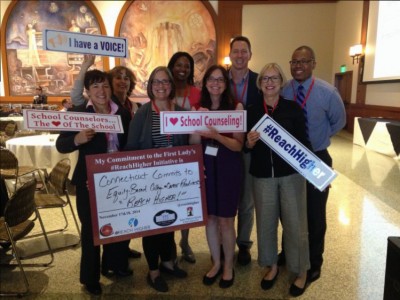
When the White House organized the nation’s first-ever summit focused on improving school counseling and college advising last year, experts from UConn’s Neag School of Education were among those invited to speak and share ideas as recognized leaders.
Headed by Neag Counseling Program Associate Professor Rachelle Pérusse, the Connecticut team of seven – including partners from the Connecticut College Access and Success Program and national ECMC Foundation – presented strategies currently being used in Connecticut to increase the overall number of students attending postsecondary schools, with a particular focus on students of color who would be the first in their families to earn a college degree.
“No data is bad data, and whatever we discover about our efforts will only serve to improve school counseling services, which we are thrilled to have finally come into the spotlight.” —Associate Professor Rachelle Pérusse
These tactics include adding additional equity-based college and career readiness education to the Neag School’s master’s-level school counseling curriculum; providing Neag counseling students and working school counselors with the proven college-awareness and preparation training evaluated by educators at the University of California at Berkeley; and establishing a data-driven system to measure the process, content, and outcome of these efforts.
“No data is bad data, and whatever we discover about our efforts will only serve to improve school counseling services, which we are thrilled to have finally come into the spotlight,” Pérusse says. “The invitation to the summit led to us putting together this team, and creating partnerships, which is exciting. Without the team, all of us involved would be working passionately on our own to improve school counseling and college readiness,” she continues. “But as a team, our power and vision is so much larger, and our resources so much stronger. Together, we’ll be able to better connect the dots to reach all those involved in getting kids ready for college or a career, which includes not just the student, but parents, teachers, extended family members, and community members.”
Support for School Counselors
Held in partnership with the White House’s College Opportunity Agenda and the First Lady’s Reach Higher Initiative, the November summit was designed to be the first of a series of discussions leading to new national and state policies about school counseling. First lady Michelle Obama attended via videoconference, stating that “if we truly want to help young people reach their college dreams, we need to support our school counselors.”
Those words delighted UConn team member and graduated Neag doctoral student Jennifer Parzych, who said the importance of school counselors is often overlooked.
“What many don’t realize is that postsecondary readiness – meaning the student is prepared after high school to attend a four-year college, community college, or technical school – really begins in kindergarten, because it’s not just about a young person getting good grades,” says Parzych, who also serves as president of the Connecticut School Counselor Association. “It’s about a young person believing he or she is capable to go to college, that they have needed resources, that their parents are involved and encouraging their child to continue their education, and that all are aware of available options.”
Connecticut Department of Education consultant Kimberly Traverso, also a member of the team, says she’s excited about UConn’s plans to expand a three-credit, equity-based college and career readiness course for school counselors: “I think the talent acquisition of our Connecticut task force is very diverse, which is a critical ingredient for maximizing system efficiency and leadership. Strengthening partnerships between universities and school districts will build a sustainable infrastructure that includes collaboration across internal and external boundaries. More than ever, school counselors have the opportunity to impact student outcomes, reduce barriers, and create equitable options.”
How Counselors Can Help
While the recommended national average is one counselor for every 250 students, the ratio in some Connecticut elementary schools is one counselor for every 1,000 students.
“The good news is that Connecticut high schools are pretty much aligned to the national ratio,” Traverso says. “In some districts, counselors are at the forefront. But in others, where counselors’ significance hasn’t yet been recognized, students may not maximize their potential.
“One of the goals of our team is to educate districts about how counselors can improve attendance, behavior, and achievement, starting as young as elementary school. When this occurs, everyone is not trying to play catch-up in high school.”
There’s a great deal of information to share with districts, Pérusse says, including the White House-backed Reach Higher Initiative that, like the focus on school counselors, is geared to inspire students to continue their education past high school.
Other Connecticut team partners working toward this end include Mark Danaher, president of the National Career Development Association; Holly Franquet, director of The College Place in Connecticut; March Kessler, executive director of the ECMC Foundation; Erik Hines, assistant professor in school counseling at the Neag School; and Neag alum Vanessa Montorsi ’04 MA, school counseling department head at Cheshire (Conn.) High School, and a semifinalist in the first-ever School Counselor of the Year Award, presented in January by Mrs. Obama.
“All of us involved are committed to making a difference for children, particularly for those who face obstacles related to poverty, ethnicity, and first-generation students,” says Pérusse. “When I teach, I tell my graduate students: ‘As a school counselor, you must be passionate about school counseling and being a force for equity and change.’”
 Facebook
Facebook
 Twitter
Twitter
 LinkedIn
LinkedIn
